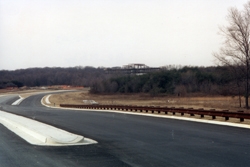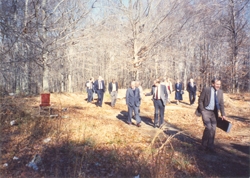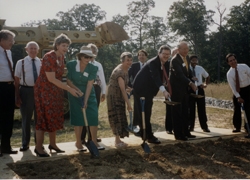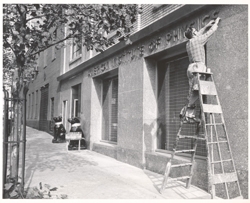By Molly Marcusse, Archives Assistant

2013 marked twenty years in the American Center for Physics for the American Institute of Physics (AIP), American Physical Society (APS), American Association of Physics Teachers (AAPT), and American Association of Physicists in Medicine (AAPM). In 2013 the NBLA also processed and made available the records of AIP’s former treasurer Arthur Bent (1989-1997), which includes a series of records relating to AIP’s move from New York City, NY to College Park, MD and the creation of the American Center for Physics. These records from the Office of the Treasurer provide a glimpse into the efforts required to make the headquarter move successful.

Before settling on College Park as the site, visits were made to locations in Northern Virginia, Philadelphia, and Baltimore. Prince George’s County in particular was favored because AAPT was already located on Berwyn Road in College Park. Other factors which were considered when choosing the new headquarters location were the cost of land, timetable of development and construction, density and nature of existing buildings and control over new buildings, presence of hotel and other nearby services, and proximity to a metro station, the Beltway, and a university. AIP, APS, and the ACP steering committee were all interested in a site which had the ability to make a statement for physics with the new headquarters. Arthur Bent in particular preferred ACP’s current location on River Road because of its location, availability of public transportation, and because he felt this site had the most potential to bring in other scientific, engineering, or educational organizations.

Once the site was selected, the Oliver Carr Company was chosen as the development agent and Skidmore, Owings & Merrill was chosen as the architect. The building was designed to get as much air and natural light as possible into offices, to be energy conscious, and to preserve the natural beauty of the site. The NBLA was designed as the architectural focus of the building. The ACP steering committee tasked Skidmore, Owings & Merrill “To design a crisp, fresh, modern appearance symbolizing Physics as the science of discovery.” The building was also designed to allow for future expansion on-site; it is estimated that the current land will allow for expansion to quadruple the current usable office space if needed.

As construction proceeded, the ACP steering committee had a number of decisions to make. “Physics Ellipse” was the committee’s first choice for the name of ACP’s street, which was accepted by the Post Office. If this was not an option, “Physics Loop” and “Physics Way” had been offered as alternatives. A new logo for ACP was proposed by Richard Giegengack as a potential flag design based on a truncated version of the AIP logo designed by Michael Donovan. The steering committee liked the truncated logo so much that they adopted it as the logo for the building overall. The former AAPT offices on Berwyn Road had been named the Homer L. Dodge Building in honor of their first President; in addition to his work for AAPT, Homer Dodge was involved in both APS and AIP. The Berwyn Road building is still named after Homer Dodge but a plaque in his honor has been moved to the AAPT offices in the American Center for Physics.

AIP’s previous headquarters on 45th Street in NYC was sold to the Republic of Korea for use by the Korean Mission to the U.N. Occupation of ACP began October 15, 1993, although the College Park metro station did not open until December 1993. The American Center for Physics was dedicated in the evening of April 22, 1994.
